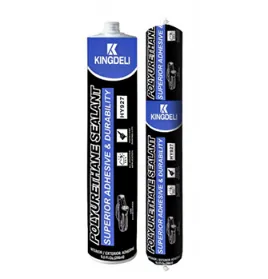How to Prevent Windshield Leaks with Polyurethane Sealant


Introduction
Windshield leaks bug car owners a lot. Water sneaking in can wreck insides, harm gadgets, and even hurt safe driving. Usual reasons? Old sealant that gets stiff, sloppy setup, or wrong stuff used. Polyurethane sealant shines as a great fix. It grabs tight and bends well to stop leaks for good. This guide jumps into ways to block windshield leaks using polyurethane sealant. It shares handy tips for results that stick around.
Why Windshield Leaks Happen
Common Causes of Windshield Leaks
Leaks around windshields come from a handful of main problems. Sealants get old and stiff over time. They lose their hold. Bad setup, such as lumpy sealant or poor joint setup, lets water slip in. Glass and car body parts expand at different speeds. This makes gaps. Small dents or bumps from crashes can break the seal too. Water creeps through then. Have you seen a small drip after washing your car? That’s usually the first hint trouble’s brewing.
Risks of Ignoring Windshield Leaks
Don’t brush off leaks. It’s risky. Water soaks seats and floors. It leaves nasty spots or musty odors from mold. Gadgets like dash sensors can fry out. Fixes cost big bucks. In bad cases, leaks fog the glass. You can’t see well to drive. That’s dangerous. A little seep now might spell huge woes later.
Why Polyurethane Sealant is Ideal for Windshield Bonding
Superior Adhesion to Multiple Materials
Polyurethane sealant clings tough to all sorts of stuff. It sticks great to aluminum, steel, composites, and glass. That’s why folks pick it for windshields. The firm hold keeps it in place, even with shakes. It works on smooth sedans or tough trucks alike.
Flexibility and Durability
Cars shake, bend, and deal with hot and cold shifts. Polyurethane sealant takes those jolts without splitting. It copes with heat stretch and cold shrink. The seal stays snug. And it fights off weather, water, and sun rays. So it hangs on for years. That means less fixing and fewer headaches.
Advanced Polyurethane Sealant Features
Kingdeli’s polyurethane sealants excel in windshield jobs. They set quick, which helps speed up work. Tiny shrink and no-yellow tricks keep the seal neat. Super strong bonds boost crash safety. The glass stays locked in. These perks make Kingdeli a smart pick for solid outcomes.

Step by Step Guide to Prevent Windshield Leaks
Surface Preparation
Prep right is key. First, wipe the glass and body spots clean. Get rid of grime, oil, or old goo with a solvent wipe. Scrub fast with a wire brush or sandpaper on bumpy areas. It helps grip better. Clean spots let sealant latch on strong. That cuts leak chances. Skip prep? You’re begging for fails.
Choosing the Right PU Sealant
Pick smart for polyurethane sealant. Look at set time, heat limits, and bendiness. Windshields need one with top bounce back and firm stick. Kingdeli has fast set, low shrink, tough kinds just for cars. Match it to your task. Then you get top notch work.
Proper Application Techniques
Putting on sealant mixes skill and care. In auto lines, machines squeeze even lines. By hand, grab a caulk gun. Keep the line steady though. Shoot for 4-6 mm thick and width to fit the space. Push glass down hard for good touch. Lumpy work makes weak points. So go steady.
Curing and Inspection
Set time hinges on warmth and wet air. Most need 24-48 hours in normal room temps to harden full. Park the car dry and toasty to hurry it. Once done, hose test for seeps. Check for splits or bubbles in the goo. Spot issues? Slap on matching polyurethane sealant quick. Fix before it grows.
Maintenance Tips to Ensure Long Term Leak Prevention
Regular Inspection and Cleaning
Peek at the sealant every few months. Hunt for splits, flaking, or color shifts. A light wipe with soft cleaner clears dirt and crud. Piled up junk weakens it slow. Checks spot tiny woes early. That stops big leaks.
Addressing Early Signs of Failure
See a small split or wee drip? Act fast. Don’t dawdle. Wipe the spot. Dry it out. Then dab thin compatible polyurethane sealant. Quick patches now dodge huge jobs later. Bad damage? Swap the whole line. It brings back strong seal.
Conclusion
Polyurethane sealant packs power to stop windshield leaks. Its tight grab, bend, and toughness fit perfect for blocking water and holding glass safe. Kingdeli’s smart mixes, with quick set and high power, give trusty work. Pick good polyurethane sealant. It means safety and long hauls without drips. A bit of watchfulness keeps leaks away.
FAQ
Q1: What makes polyurethane sealant better than silicone for windshields?
Polyurethane grabs harder and bends more. It’s great for sticking glass to metal or composites. It takes shakes and temp swings better. Silicone fights sun well, but lacks muscle for car needs.
Q2: How long does polyurethane sealant take to cure?
Most set in 24-48 hours. It varies with warmth and damp. Hotter and drier speeds it up.
Q3: Can polyurethane sealant be painted over?
Yep, lots can take paint once hard. That makes ’em handy for looks that need finish.
Q4: How often should windshield sealant be inspected?
Check every 3-6 months for wear or cracks. Steady peeks nab probs soon. Stops leaks.
Q5: What happens if a windshield leak is ignored?
Water wrecks insides, zaps gadgets, and clouds sight. That spells danger and pricey fixes.
